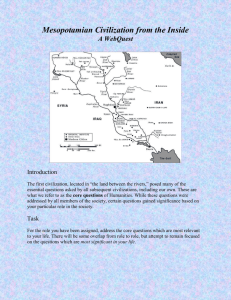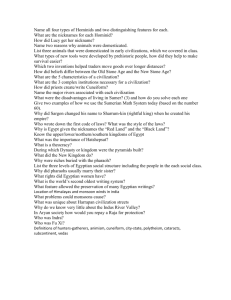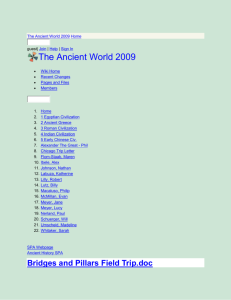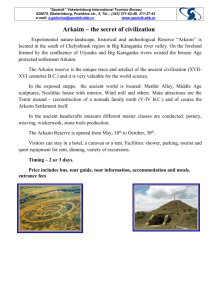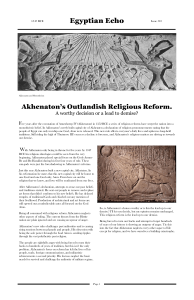Study Guide for Chapter 1: The Beginnings of Civilization Directions
advertisement
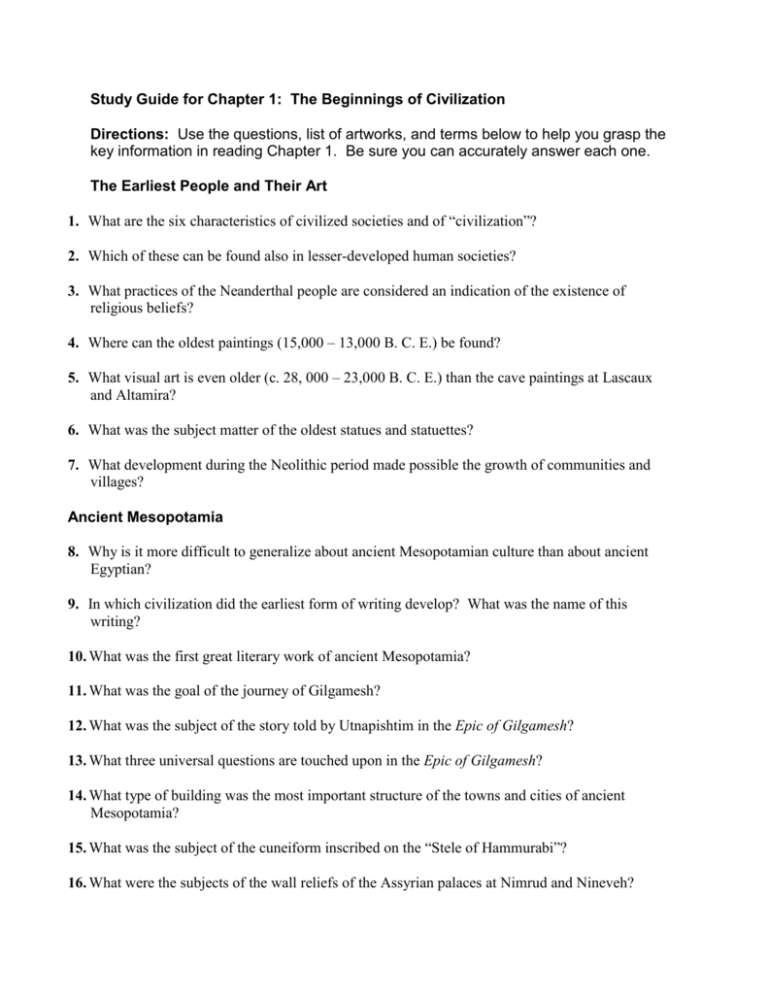
Study Guide for Chapter 1: The Beginnings of Civilization Directions: Use the questions, list of artworks, and terms below to help you grasp the key information in reading Chapter 1. Be sure you can accurately answer each one. The Earliest People and Their Art 1. What are the six characteristics of civilized societies and of “civilization”? 2. Which of these can be found also in lesser-developed human societies? 3. What practices of the Neanderthal people are considered an indication of the existence of religious beliefs? 4. Where can the oldest paintings (15,000 – 13,000 B. C. E.) be found? 5. What visual art is even older (c. 28, 000 – 23,000 B. C. E.) than the cave paintings at Lascaux and Altamira? 6. What was the subject matter of the oldest statues and statuettes? 7. What development during the Neolithic period made possible the growth of communities and villages? Ancient Mesopotamia 8. Why is it more difficult to generalize about ancient Mesopotamian culture than about ancient Egyptian? 9. In which civilization did the earliest form of writing develop? What was the name of this writing? 10. What was the first great literary work of ancient Mesopotamia? 11. What was the goal of the journey of Gilgamesh? 12. What was the subject of the story told by Utnapishtim in the Epic of Gilgamesh? 13. What three universal questions are touched upon in the Epic of Gilgamesh? 14. What type of building was the most important structure of the towns and cities of ancient Mesopotamia? 15. What was the subject of the cuneiform inscribed on the “Stele of Hammurabi”? 16. What were the subjects of the wall reliefs of the Assyrian palaces at Nimrud and Nineveh? 17. What last great Mesopotamian civilization did the Persians conquer? How far east did the Persian Empire extend? How far west? Who conquered the Persians around 330 B. C. E.? Ancient Egypt 18. What was the influence of the Egyptian god Aton-Ra on the chaos of the primeval universe? 19. Who was the first great architect known to history? What did he build? 20. What was the purpose of the pyramids of the Old Kingdom? What colossal statue stood next to the pyramids at Giza? 21. What was the most important religious idea of the New Kingdom? What pharaoh is most associated with this concept? 22. What new capital city was established by Akhenaton? 23. What is the significance in the change of the name Amenhotep IV (Amenhotep) to Akhenaton (Akhenaton)? 24. How did the “Amarna art” of the pharaoh Akhenaton differ from conventional Egyptian art? 25. Which queen of this period is the subject of perhaps the most famous of all Egyptian portraits? Who was her husband? 26. In the illustration of Akhenaton, Nefertiti, and Three of Their Children (Figure 1.15), is the pharaoh shown as all powerful? What is the object depicted at the top center of the relief? 27. What event in 1923 increased the fame of Tutankhamen? 28. What adjective best describes the temples built by Ramses II at Luxor, Karnak, and Abu Simbel? 29. What was the most striking feature of the 3,000 year-old culture of ancient Egypt, especially in contrast with the history of the cultures of Mesopotamia? Aegean Culture 30. During the Bronze Age, what was the most important urban center of Aegean culture on Crete? On the mainland of Greece? 31. What was the most common subject of the art of the Cyclades Islands? 32. Where and what was the Labyrinth? What was the Greek myth of the Minotaur, Theseus, and Ariadne? 33. Why did Sir Arthur Evans refer to Crete as Minoan civilization? 34. What two reasons did Evans give for his success as an archaeologist? 35. Who was the central figure of Minoan religion? 36. What war provided the background for Homer’s Iliad and Odyssey? 37. What were the two most important archaeological discoveries of Heinrich Schliemann? According to Schliemann, what city of Homer was buried beneath the Roman city of Ilium? Define or Identify Paleolithic Neolithic (development of agriculture and settled communities) “The land between the rivers (the Tigris and the Euphrates)” Sumer: The first civilization Uruk (Warka) Cuneiform Old, Middle, and New Kingdoms Nile River (“the gift of the Nile”) Osiris, Isis, Horus Akhenaton Monotheism Amarna Art Hieroglyphics Labyrinth Significant Works to Remember Venus of Willendorf, c. 30,000 – 25,000 B. C. E. Lascaux Cave Paintings, c. 15,000 – 10,000 B. C. E. Epic of Gilgamesh Stele of Hammurabi’s Code of Law Ziggurat at Ur Lady of Warka Assyrian Wall Reliefs Imhotep and the Step Pyramid of Zoser Sphinx and Pyramids of Giza Bust of Queen Nefertiti Cycladic Statues Palace of Minos at Knossos Minoan Snake Goddess Key Terms Homo Erectus Homo Sapiens light-wells Neanderthal Neolithic Paleolithic pyramid Ramapithecus Semitic ziggurat cuneiform hieroglyph
